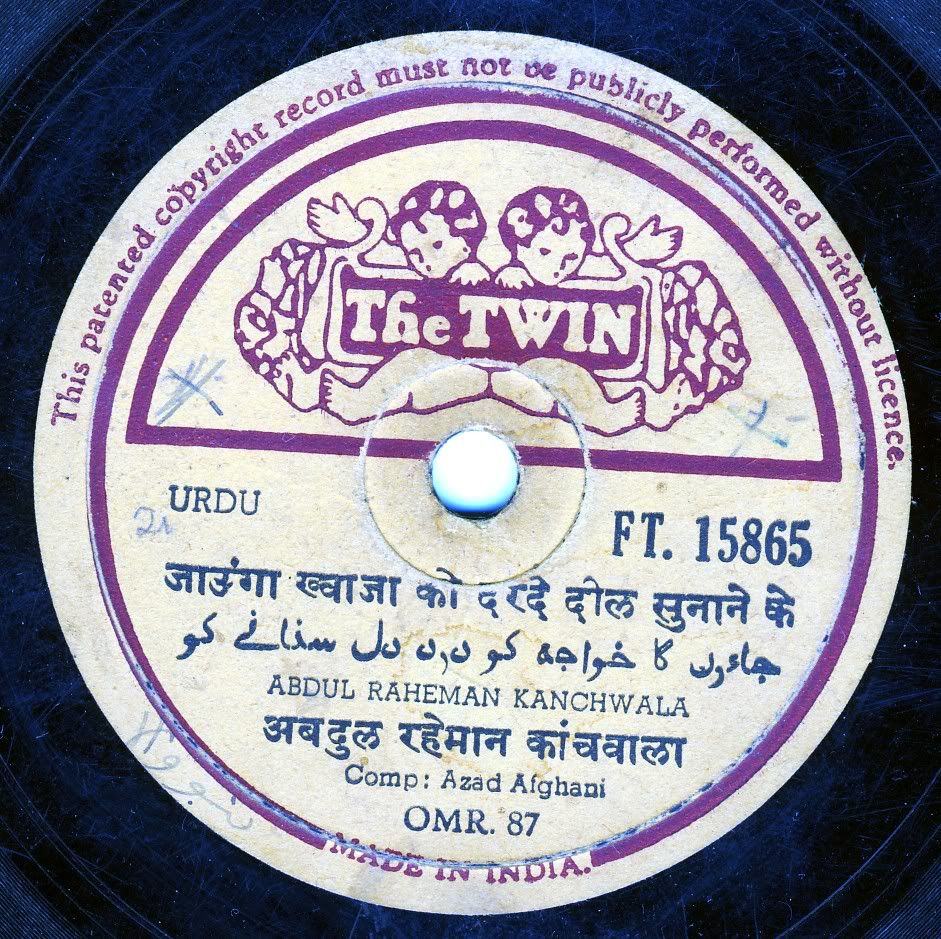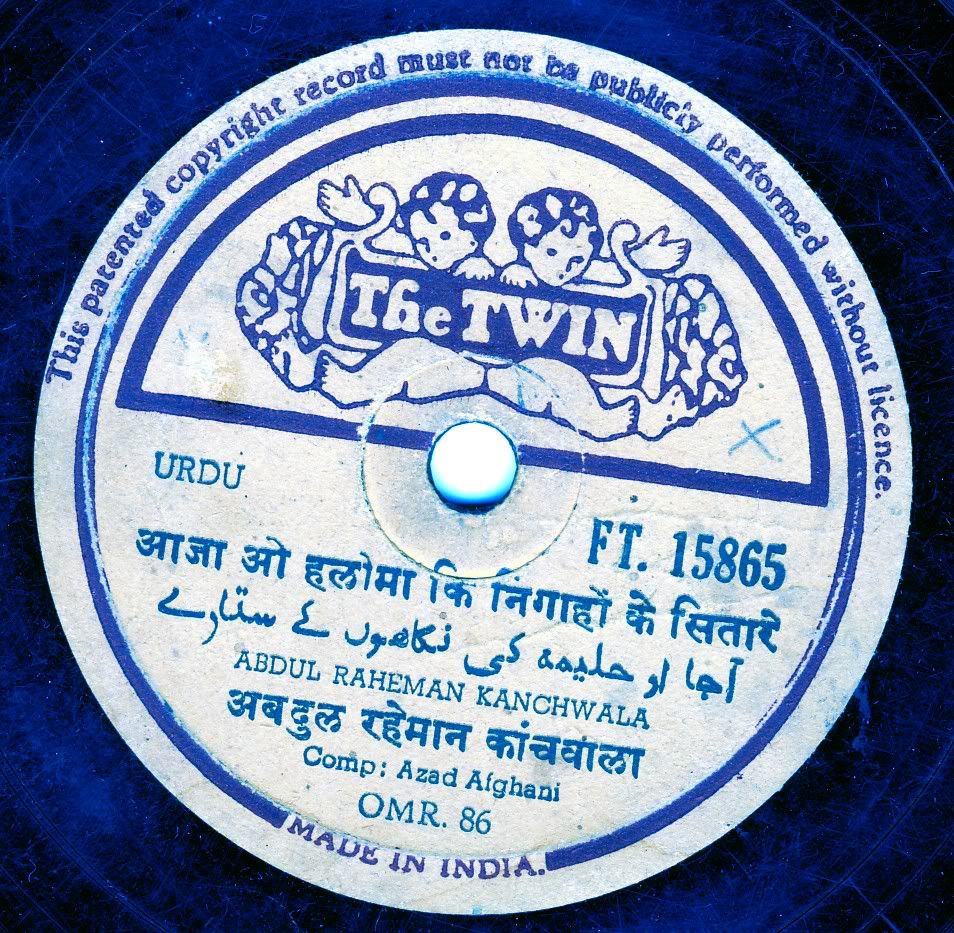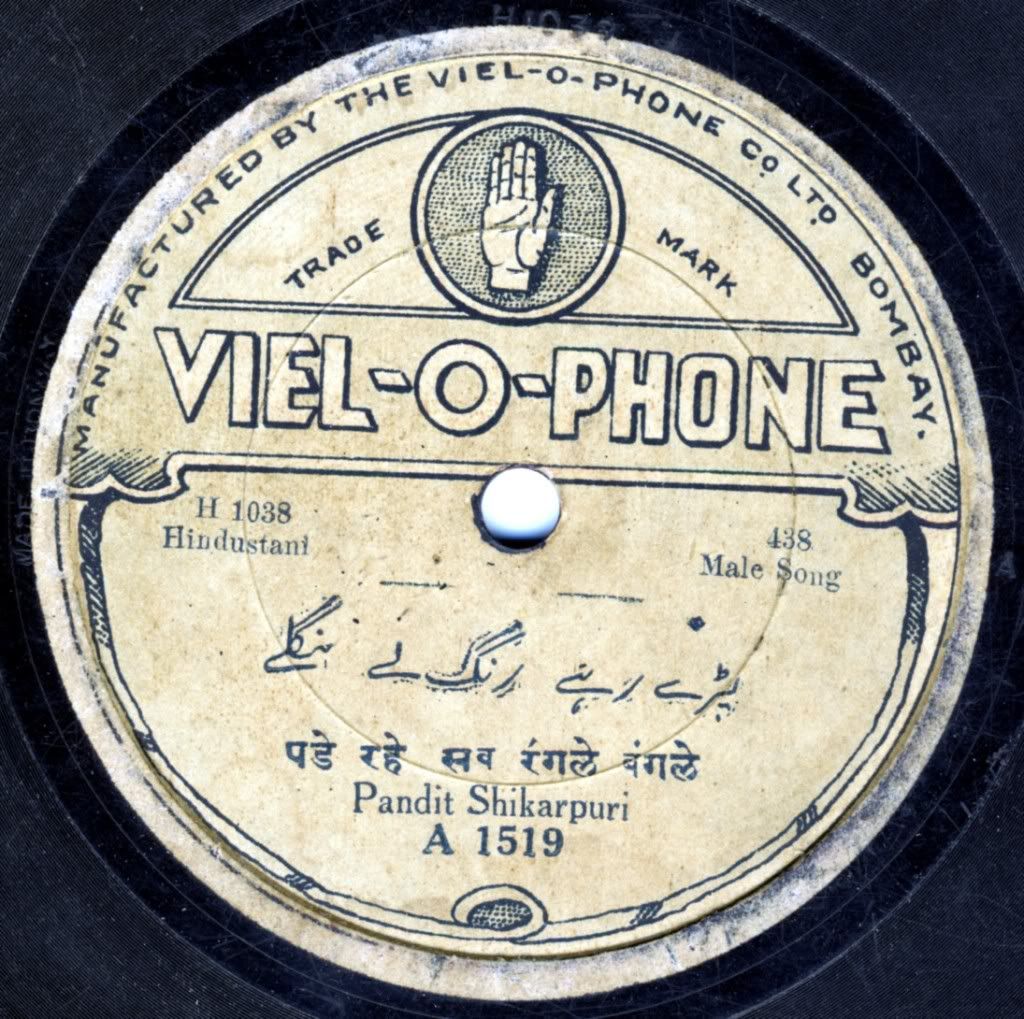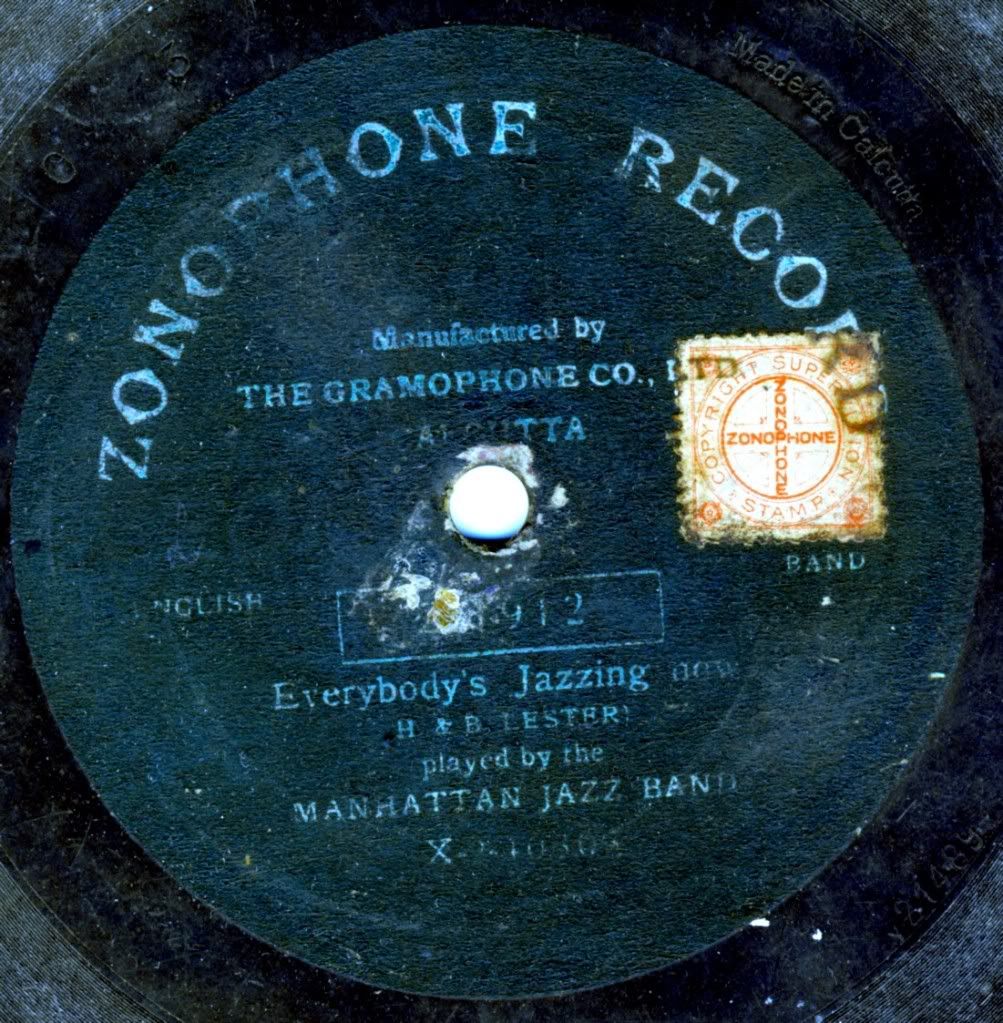India Indian music music vocalists: 78 rpm discs bhajan falsetto genius
by Warren
3 comments
Meta
SiteMeter
Brighter Planet
78 rpm Records of Indian Music: Pyare Saheb — India’s Countertenor
Pyare Saheb was one of the most esteemed voices of turn-of-the-century Hindustani tradition. Singing always in a high falsetto, he recorded literally hundreds of 78 rpm discs and enjoyed high esteem amongst rasikas, especially for his sensitive handling of thumris. His music, alas, is now almost completely forgotten. Here are two samples of his singing — a popular devotional song (with some fabulous extemporized ornamental passages) and a beautiful rendition of the rarely heard raga Sorath.


Bhajan: He Govind He Gopal
Raga Sorath: Dekhori na mane Shyam
India Indian music music vocalists: islam naat Quawwali
by Warren
3 comments
Meta
SiteMeter
Brighter Planet
78 rpm Records of Indian Music: Abdul Raheman Kanchwala & Sufi Quawal (of Patiala)
Some terrific quawwali singing from Abdul Raheman Kanchwala (who appears to have continued a performance career into the relative present, judging from the results of a little googling) and the anonymous Sufi Quawal (of Patiala). Both of these recordings were part of the collection purchased in Udaipur in 2000.


Abdul Raheman Kanchwala: Jawoonga Khwaaja dard-e-dil sunane ke
Abdul Raheman Kanchwala: Aa jaa o halima ki nigahen ke sitare


Sufi Quawal (of Patiala): Aa mota dilaka khatkaa
Sufi Quawal (of Patiala): Ab to mera bimahi bhi
India Indian music music vocalists: 78 rpm discs musical theater
by Warren
leave a comment
Meta
SiteMeter
Brighter Planet
78 rpm Records of Indian Music: “Khaki Putla” — featuring Mianbhai and Mahomed
I can’t offer much beyond inferences about these two sides on the Zonophone label. My guess is that “Khaki Putla” was the name of a drama, and these two songs are part of the complete “soundtrack.” Mahomed, the singer on “Tap karna aaya,” has very nice technique.


Mianbhai: Aay maula arabhi
Mahomed: Tap karna aaya
India Indian music music vocalists: genius
by Warren
leave a comment
Meta
SiteMeter
Brighter Planet
Jawab Nahin.
Raga Kafi: Piya to manata nahin. This looks and sounds like a mid-70s recording.
India Indian music music vocalists: 78 rpm discs musical theater Parsi
by Warren
2 comments
Meta
SiteMeter
Brighter Planet
78 rpm Records of Indian Music: Sorabji Katrak of the New Alfred Company
These songs are part of the early 20th century culture of musical theater in Bombay. The New Alfred Theatre Company was founded in the late 19th century by Kawasji Palanji Khatau to present plays in Gujarati, Marathi and Hindi.
Kavasji belonged to a poor family and lived in the Sankary lane near ‘Dukkar Bazzar’ (pig market) around ‘Dhobi Talao’ area [a place very close to Metro cinema]. Amrut Keshav Nayak was the director of the plays staged. He staged several plays including Murad, Allauddin, Gorakh Dhanda, Mahabharat, Asir-e-hirs, Abhimanu, Chandraval, Harishchandra etc. Alfred company had many owners in 60 years: Nanabhai Rustomji Rana, Mohammad Ibrahim, Manekji Master. Later on Mr. Khatau once again owned it and renamed it as ‘New Alfred Theater Company’. The company was operational until about 1932 with last ownership of Jahangir, son of Mr. Khatau. Along with the Alfred Company, some amateur and professional companies also staged Urdu and Parsi plays and toured to Calcutta and Rangoon in Burma.
Around 1905, many record companies approached these companies and cut discs of songs and dialogues. Beka records, Sun Disc, Gramophone Company, Ramagraph, James Opera cut over 300 songs of renowned artists: Master Mohan, Master Bhagoo, Dayashankar Vasanji, Sorabji Katrak, Ibrahim, Bhurekhan, Meer Himmat Kalu alias Master Himmat, Murad Ali, Phiroz Shah Misrty and many others.
Sorabji Katrak was one of the popular male vocalists from the Alfred Company.
Gujrathi theater was full of actors from Saurashtra, North Gujrath and Mumbai. {snip} Among Parsi’s were: Sorabji Katrak, Sorabji Kerawala, Sorabji Dhondi and Ferdoon Irani.


I am assuming these lyrics are Gujarati — perhaps someone can figure out more?
Education music: gamelan prison reform
by Warren
1 comment
Meta
SiteMeter
Brighter Planet
This Makes Me Happy
My vocational connection with academic ethnomusicology is pretty tenuous most of the time, but I get the SEM Journal every quarter, and it’s one of my small continuing pleasures, being constantly full of really really really interesting ideas and equally cool music.
The Fall 2010 issue of Ethnomusicology led off with a piece that gave me a morale boost. Let me tell you about it; it will make you feel better, too. We all need Good Vibrations, and Maria Mendonca’s article gave me some I’d like to share.
Gamelan in Prisons in England and Scotland: Narratives of Transformation and the “Good Vibrations” of Educational Rhetoric
And it leads off:
“Good Vibrations,” an education project featuring Javanese gamelan, has taken place in different formats in a variety of prisons in England and Scotland since 2003, developing with considerable success.
{snip}
As far as the prisoners and gamelan tutors are concerned, participation in the project can be seen to build self-confidence and develop social skills that help individuals to cope with life inside, and which may lead to more long-term changes. From the prison educationalists’ viewpoint, the numbers are convincing: an unusually high percentage of the participants in the gamelan prison projects (who are often drawn from the most marginalized prison populations) go on to be involved in more traditional education courses in prison. From the prison authorities’ and governments’ perspectives, involvement in education in prison has been statistically proven to combat re-offending, which is an enormous financial (not to mention social) problem in an overstretched prison system.
In other words, this is a very successful program.
Statistics from recent projects suggest that the gamelan projects have been particularly effective in this respect, with over 50% of participants (none of whom had formerly been involved in prison education) continuing to other, more mainstream education classes.”
Let’s stop for a second. Do you know what a gamelan is, or am I not making sense?
Here’s wiki to help:
A gamelan is a musical ensemble from Indonesia, typically from the islands of Bali or Java, featuring a variety of instruments such as metallophones, xylophones, drums and gongs; bamboo flutes, bowed and plucked strings. Vocalists may also be included.
The term refers more to the set of instruments than to the players of those instruments. A gamelan is a set of instruments as a distinct entity, built and tuned to stay together – instruments from different gamelan are generally not interchangeable.
The word gamelan comes from the Javanese word gamels, meaning “to strike or hammer”, and the suffix an, which makes the root a collective noun.

Perhaps you went to a college that owns a set of gamelan instruments. I teach in a room full of them, an interesting experience in resonance and echo. If you’ve heard the music, you’ll remember it: curiously (wonderfully!) tuned rhythmic chimings full of hypnotic patterns and sinuous melody.
I’ve heard a fair bit of gamelan music; you can’t be even an en passant ethnomusicologist without hearing a lot of gamelan. Aside from the beauty of the music and the tangibility of the instruments, the form is also popular because many of the orchestral parts don’t require virtuoso technique, but simply careful attention and calm mindfulness — traits which the music’s structure reinforces.

I’d never imagined anyone could get this music into prisons.
What a truly wonderful idea…I thought to myself, as I looked up Good Vibrations’ website, and read:
Good Vibrations is a registered charity (number 1126493) that helps prisoners, patients in secure hospitals, ex-prisoners and others in the community to develop crucial life and work skills through participating in intensive Gamelan (Indonesian bronze percussion) courses. Since 2003 Good Vibrations has worked with more than 2400 participants in 33 different secure institutions. Gamelan is an extremely effective tool for achieving our aims:
* It is very accessible
* You don’t need to have any previous musical experience
* You don’t need to be able to read music
* It’s easy to learn the basics
* It’s a very communal activity – there is no overall conductor or leader and everyone’s contribution is equally important
* You have to listen to everyone else to fit your own part inAbout Good Vibrations
A Good Vibrations project typically runs as a week-long course for a group of 15 – 20 participants. Most will not have done anything musical before. At the end of the week the group puts on an informal performance. Each performance is recorded and a CD is produced, a copy of which is given to everyone who has taken part. Participants will benefit enormously from the short but intensive experience.
===================================================
In a world that’s full of grand and petty deceits, of the worst intentions magnified and the best intentions betrayed, isn’t it a pleasure to see something that actually works for the greater good?
A participant in the Good Vibrations program
Gamelan (Indonesian bronze percussion orchestra) is special for a number of reasons including:
* It is quick and easy to learn the basics and a beginners group will quickly get good results.
* It provides an extremely accessible creative experience (and we believe that the opportunity for creative expression is essential for everyone).
* It is exceptionally communal: there is no overall leader or conductor, everyone’s contribution is equally important, you have to listen to everyone else to fit your part in; and to a large degree, the shape and content of a piece is determined by a group as it goes along.
* It is endlessly flexible: it is adaptable for all abilities even within the same group; there are countless routes for progression and development.
* It allows for real diversity: it brings people together from diverse groups and allows for diverse ideas and approaches.
* There is evidence that the sound of gongs and similar instruments is therapeutic.
* Playing Gamelan creates the state of “flow” (total absorption in a task, and the ongoing satisfaction and loss of self-consciousness that brings) which is essential to a person’s well-being.
A participant in the Good Vibrations program
Mendonca quotes Malcolm Miller, one of the project’s tutors:
“It’s the nature of gamelan; it’s a whole community and you work together to achieve an aim. The way people work together to make music is, in a way, a reflection of how people work together effectively in real life. And for a lot of them [the prisoners], that’s not how they’ve ever worked… And so in that respect it is a communication thing, but music is something that facilitates it.
Mendonca: Gamelan in Prisons
Ethnomusicology, Fall 2010, p. 383
and she shares some of the prisoners’ responses to her questions about the project:
“For some, the project had enabled them to socialize with other prisoners, in one case for the first time since being inside. Isolation can be extreme in prison. As one prisoner remarked to me, with a sense of relief and connection that seemed out of proportion with the small act he was describing, ‘now if I pass one of these blokes on the wing, I can actually not to them from afar.’
“A group of responses focused on self-esteem: ‘…on the wing you’re in your own little world, just surviving…gamelan has made me stronger; it has…broken me out of my own four walls…it has helped me face prison. When I came in I was a wreck. I didn’t want to get on, and I just wanted to give up. It has taught me that you can find good in here.’ “
Mendonca: Gamelan in Prisons
Ethnomusicology, Fall 2010, p. 384
The project’s website includes more testimonials from prison participants:
“I’d like to say something about where I was before [the GV course]. I’d been seriously depressed, wanting to top myself. I was completely lost, no sense of how I could get back to normality. The gamelan course, at that time, was a step up to getting back to some form of normality. That’s why I grabbed hold of it with two hands, I needed it. A really positive focus was just what I needed at the time, something to give me a sense of self-worth.
“[Good Vibrations] is nothing to do with the criminal justice system directly, there’s a sense of freedom, it’s relaxed, not compulsory. There’s no hidden agenda. [Doing the course] was totally my choice which helped a lot. The criminal justice system is so negative, all about what’s wrong with you. It’s good to have something positive which works with you as an individual and is all about what you can offer – a very powerful message in itself. This is what got me on the road to recovery.”
“After last year(‘s project) I did a Group & Teamwork exam – I based it on what I did in gamelan. I passed that. If I’d not done Gamelan, I would not have done Group & Teamwork – I wouldn’t have been able to. I’m usually a quiet person, don’t gel with others, this brought me out of my shell and now I can work in a group.
“It (Good Vibrations) gives you confidence the first thing I’d ever done in front of an audience. Now I’m doing drama. It gave me confidence to sign up for drama – we’re performing in front of an audience [from outside] next week. I’ve signed up for dance – starts on Friday. I’ve self-harmed since I was 9, I’ve never gone this long [without self-harming]. Now I think of the music.”
The best part, of course, is the music. I couldn’t find any videos of these workshops; I would imagine that there are security issues that arise when you’re trying to film inside a prison. But there’s a lovely page of musical samples from various prison groups. Please go and check them out.
If you live in the UK and are interested in attending one of the project’s “play-throughs,” performances of their ongoing work, you can get connected here.

They have a CD for sale. I think I’m going to buy a copy. Maybe more than one.
==============================================
I gave up believing that music alone would save the world when I learned that old Prescott Bush loved to sing more than anything.
But I have never stopped believing that without music, we haven’t got a chance.
Thank you for letting me share these Good Vibrations with you.
India Indian music music vocalists
by Warren
3 comments
Meta
SiteMeter
Brighter Planet
78 rpm Records of Indian Music: Pandit Shikarpuri
No information seems to be available about Pandit Shikarpuri. Perhaps, as his name suggests, he’s originally from Shikarpur.


Homeopathic doses of information are available about the record label:
Michael Kinnear says this about Viel-o-phone:
…Valabhdas Runchordas established his own record pressing factory in 1914 under the name of the Viel-o-phone Co., Ltd., in Bombay.
On the other hand:
During 1926, Valabhdas Runchordas, who had been in the sound recording industry in Bombay since 1902, and a persistent rival of The Gramophone Co., Ltd., organised a company in the name of The Viel-o-phone Co., Ltd., with a disc record factory at Matunga, in the northern suburbs of Bombay with the co-operation of Edison Bell, Limited, London .
By mid-1927, The Viel-o-phone Co., Ltd., was producing and pressing disc records under a variety of labels, however, technical and financial problems had forced the closure of the Matunga factory by early 1933. The pressing of disc records by the Matunga factory had encouraged The Gramophone Co., Ltd., to organise a subsidiary company in the name of The Twin Record Co.,. Ltd., Calcutta, in competition with the Matunga factory, often replicating the same releases with releases on the ‘Twin’ label under pseudonyms.
These songs have distinct classical flavorings, but don’t showcase any fancy improvisation. Shikarpuri’s voice is clear and well-modulated; I quite enjoy this pair of geets.
A confession: my purchase of many of these records was purely impulsive — after going through huge stack after huge stack of grimy HMV discs, I would get heartily sick of looking at Nipper looking into the Victrola, so any labels that presented a contrast automatically went into my “to-buy” stack.
India Indian music music: 78 rpm discs East-West fusion fusion music
by Warren
3 comments
Meta
SiteMeter
Brighter Planet
78 rpm Records of Indian Music: K.C. Mookerjee and G.C. Chatterjee
Here’s an interesting oddity, an early piece of East-West fusion music. Mukherjee and Chatterjee are playing piano and violin, accompanied by tabla. The music is only accidentally Hindustani, although the tabla player, faute de mieux, is pounding out tintaal. The pianist’s approach sounds informed by Western music, while the violinist uses Indian-style slides. The repertoire is gat-derived, with “asthai” and “antara” sections, but any raag contours are obscured, and if there’s improvisation I’m not hearing it. The slight acceleration is typical of Hindustani style.

The same recording is featured on both sides of the disc.
humor India Indian music Jazz music: 78 rpm discs early jazz novelty music
by Warren
3 comments
Meta
SiteMeter
Brighter Planet
78 rpm Records of Indian Music: The Manhattan Jazz Band
Here’s a change of pace: a disc from the “Manhattan Jazz Band,” released on the Calcutta-based Zonophone label. My best guess is this was from some point in the 1920s or 30s; the music is what was called jazz at the time — by people who didn’t know what jazz was.
In the late 1990s I picked up a great many 78s at a small store in Bombay’s Chor Bazaar. Among them were a few of these recordings of “English Music.” Apparently these were mostly recorded in England and released in India, for the enjoyment of the Brits. I had a brief fantasy that these were Indian musicians hired to play this repertoire, which would have been ethnomusicologically fascinating. Turns out that’s not what happened. Ah, well.


The amount of crud on the surface of the disc is beyond imagination.
Enjoy “Everybody’s Jazzing Now”:
And here’s “That Big Jazz Band”:
India Indian music music vocalists
by Warren
2 comments
Meta
SiteMeter
Brighter Planet
78 rpm Records of Indian Music: Mr. Chimanlal
Here is a male vocalist singing a pair of raga-based sort-of-khyal compositions. I’m not sure what relationship these songs have with the orthodox classical tradition. For that matter, the text as given on the disc label for the Bageshri doesn’t seem to match the mukhda he’s performing. (headscratch).
Mr. Chimanlal has a pleasant voice with a good upper register, and while he mostly eschews anything in the way of elaborate improvisation, he’s clearly got the technique. All of the 78s released on The Twin Records were part of the collection I purchased in Udaipur in 2000.
Anyway, here’s a song in Bageshri:
And a delightful item in Raga Bhimpalasi; in this one the written text matches the mukhda.


